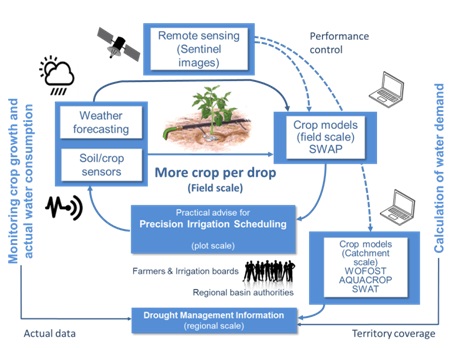OPERA
Operationalizing the increase of water use efficiency and resilience in irrigation
Partners
Partners
Evenor Tech
French National Institute for Agricultural Research INRA - EMMAH
Institute of Technology and Life Sciences
Council for Agricultural Research and Economics (CREA) – Research Centre for Policies and Bioeconomy (CREA-PB)
Abstract
Abstract
Smarter precision technologies for irrigation are needed to strengthen farmers’ adaptation to climate change. Within OPERA we distinguished two main lines of research: i) identifying ways on how farmers and irrigation organizations can react more flexible with their crop selection and production to market opportunities under climate variability; and ii) providing operational ICT technologies that allow soil water status identification and upscaling of crop water demands at field and territorial scale.
The first line focussed on stakeholder analysis to identify current bottlenecks and needs for improvement. A general approach on addressing user needs with stakeholders from the different countries was developed. In general, the needs and demands by farmers and other stakeholders varied between the different countries. This implies that different actions are needed for the different regions in Europe and South-Africa. To increase competitiveness, some farmers prefer to increase the size of their farms while others prefer improving marketing strategies or require more training for their staff. More similar results were obtained in the barriers identification for water efficiency and adopting alternative crops. Farmers from each country involved identified the cost of sensor and the high investment cost as the main barriers. In addition, administrative barriers were identified (time to obtaining water intake permit and lack of agility). The uncertainty of predicting market demands and adaptive infrastructure costs were identified as the main limitations to adopting alternative crops. The second major issue addressed was a socio-economic analysis regarding the development of irrigation advisory services, based upon the stakeholder needs. Based on econometric models and the replies from the stakeholders on questions, it was shown that farmers are actually willing to pay for an irrigation support system that results in an economic advantage over their current situation. However, this willingness expressed in terms of Euros per hectare differed between the countries. The results suggest that the policy makers, rather than following conventional command-and control method of irrigation management, will have to take into account the preferences and associated willingness-to-pay values of the farmers in a meaningful way while formulating irrigation policies.
The second line focussed on the development and field testing of ICT methods for irrigation. In total six methods were studied, involving different combinations of the use of soil-crop simulation models, remote sensing, in-situ soil and plant sensors, and weather forecast. The innovations introduced in the OPERA project mainly concern methods for estimation of crop water needs for optimal irrigation and a good distribution of water resources in shortage conditions. The assessment of water quantities is generally made to cover crop water needs in optimal conditions. The issue of deficit irrigation was addressed in one location (olive orchard irrigation). OPERA has been able to benefit from a technological breakthrough offered by the SENTINEL satellite earth observation mission, which makes it possible to develop new applications based in particular on the high temporal frequency (potentially every 5 days). In addition, the exhaustive spatial coverage and the free access to images offer guarantees for the development of operational services. Most of the methods are based on the dynamics of leaf cover. The use of soil-crop modelling is the second innovation level. Modelling makes it possible to synthesize climate, agricultural practices and soil, and thus to take into account the role of soil, which plays a buffer role against climate variability through its water storage capacity. In addition, because soil-crop models are climate-driven, they are well-suited to integrate weather forecasts. Weather forecasts can be used in irrigation scheduling (in temperate climates) and even ensemble weather forecasts can be used to determine uncertainties about the predicted root zone water content. However, the effect is dependent on the quality of the forecasts, and currently we estimate that forecasts up to five days ahead can be used. The combination of information technologies (mathematical modelling, in-situ soil or plant sensors, ensemble weather forecasts and remote sensing) in OPERA created the possibility to get more precise estimation of water demands and improve efficiency of irrigation water use in a field and larger scale.
Project structure:
Project structure:

Implementation:
Implementation:
WP1 - Identifying sector needs to increase resource use efficiency
WP2 - Forecasting water availability and critical water demand
WP3 - Guidance for optimal irrigation water strategies (case studies)
WP4 - Conceptualization of practical service models
WP5 - Project management and dissemination
Outcome/deliverables:
Outcome/deliverables:
D1.1 Report: Assessment of user requirements of the sector (month 8)
D1.2 Report: Outcome of the two stakeholder workshops (month 30)
D2.1 Reference framework (Report) defining requirements, implementation condition and evaluation procedure (month 9)
D2.2. Portfolio of methods (report, website) (month 30)
D3.1 Results of field measurements, weather forecast and simulation models that allow elaborating more precise irrigation scheduling based on actual conditions (month 24).
D3.2 Draft version of practical guidance for optimal irrigation strategies for farmers, farmer associations, local policy makers (month 26).
D3.3 Final version of practical guidance (month 28).
D4.1 Report on socio-economic assessment (month 26)
D4.2 Report on feasible service models for the irrigation sector (month 29)
D5.1 Inception report (month 3)
D5.2 Consortium Agreement signed by all partners (month 4)
D5.3 Midterm Progress report (month 16)
D5.4 Final progress report (month 30)
D5.5 OPERA scientific booklet and peer-reviewed paper(s) (month 30)